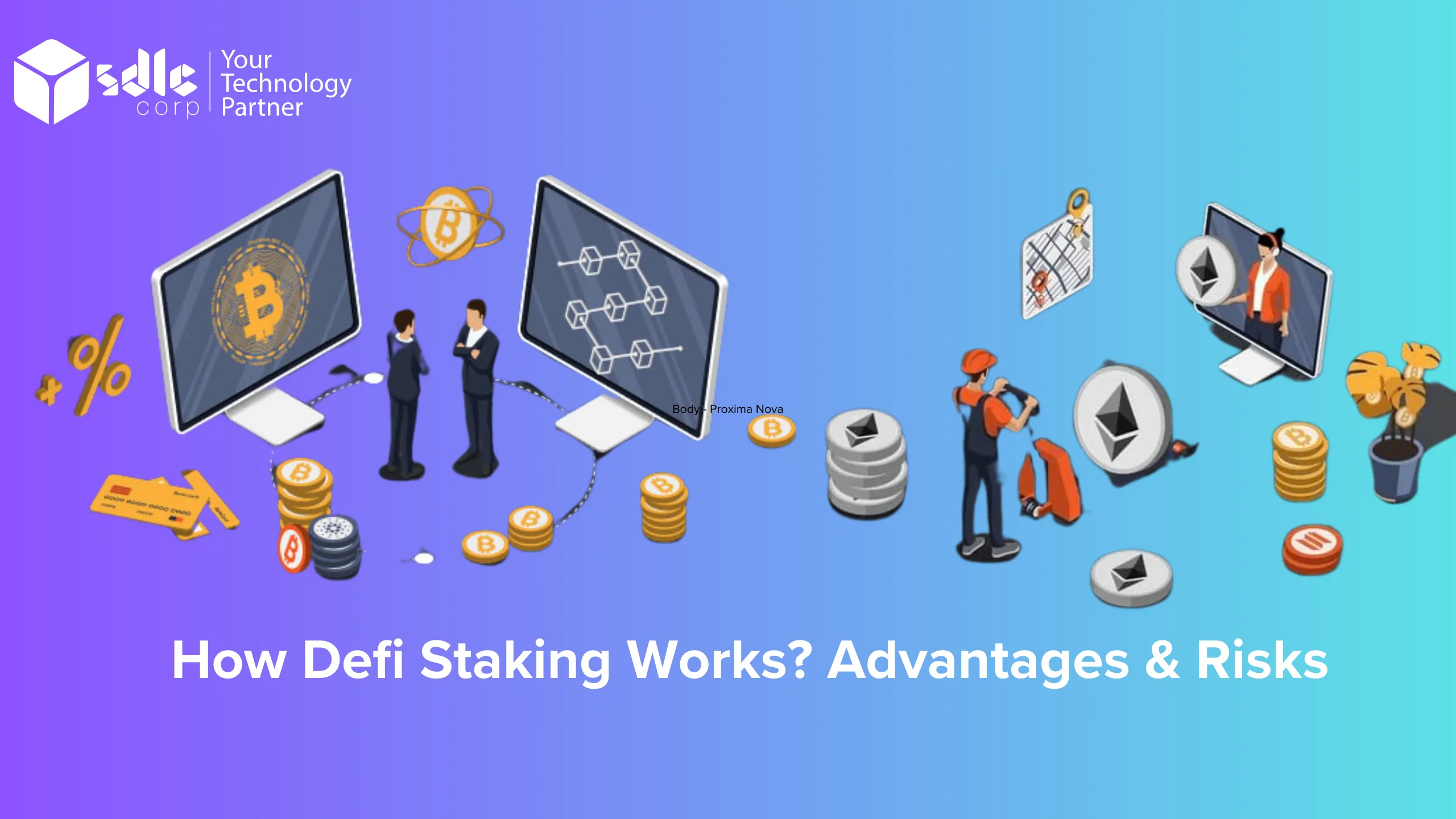What Is Defi Staking?
As for DeFi development companies, they are organizations specializing in creating and maintaining decentralized finance protocols and platforms. These companies play a crucial role in advancing the DeFi ecosystem by building innovative solutions for various financial services, such as lending, borrowing, trading, and staking. Some prominent DeFi development companies include ConsenSys, ChainSafe Systems, and OpenZeppelin. These companies contribute to the growth and evolution of DeFi by developing robust and secure smart contracts, user-friendly interfaces, and scalable infrastructure to support decentralized applications (dApps) and protocols.
Also Read: How Can DeFi Staking Unleash Its Power? Exploring Types and Use Cases
How does DeFi staking work?

1. Selection of Platform
2. Locking Up Tokens
3. Verification of Transactions
4. Consensus and Reward Distribution
5. Withdrawal and Unstaking
Now, when discussing DeFi wallet development companies, these are businesses specializing in creating secure and user-friendly wallets tailored specifically for interacting with decentralized finance applications. These wallets often come with features like built-in staking functionalities, allowing users to easily stake their tokens without leaving the wallet interface. By integrating with various DeFi platforms, these companies facilitate seamless access to staking opportunities while prioritizing security and usability for their users.
Also Read: What is Defi Staking Business Model ?
What are the different types of DeFi staking?

1. Liquidity Staking
2. Governance Staking
3. Validator Staking
4. Yield Farming
5. NFT Staking
NFT staking involves locking non-fungible tokens (NFTs) into a smart contract for a specified period to earn rewards or benefits, such as additional tokens or access to exclusive content. It combines the concept of staking with unique digital assets, allowing NFT holders to participate in token ecosystems while retaining ownership of their collectibles.
Also Read: Defi Staking Platform Development Process

What are the benefits of DeFi stakings?

- High Returns: DeFi staking often provides higher returns compared to traditional savings accounts or even some other forms of cryptocurrency investments.
- Liquidity Provision: By staking assets in DeFi protocols, users contribute to the liquidity of the platform, which is essential for its operations and can be rewarded with additional tokens or fees.
- Decentralization: DeFi staking promotes decentralization by allowing anyone to participate in securing and governing blockchain networks, rather than relying on centralized entities.
- Flexibility: Investors have the flexibility to stake and unstake their assets at any time, providing liquidity when needed without lengthy withdrawal processes.
- Community Engagement: Staking often comes with governance rights, enabling token holders to participate in decision-making processes for the future development of the protocol.
As for the best DeFi wallet, it ultimately depends on individual preferences and needs. However, some popular options known for their security, user-friendliness, and support for various DeFi protocols include MetaMask, Trust Wallet, and Ledger Nano S. These wallets offer features such as multi-asset support, easy integration with decentralized applications (dApps), and robust security measures to safeguard users’ funds.
What are the advantages of DeFi staking platforms?

Moreover, DeFi staking platforms often provide users with flexibility and control over their investments. Users can choose which assets to stake, how much to stake, and for how long, allowing them to tailor their staking strategy to their individual preferences and risk tolerance.
From a business perspective, the DeFi Lending business model can be lucrative for platform operators. They can generate revenue through various means, such as charging fees on staking transactions or offering additional services to stakers. Furthermore, by building a loyal user base and establishing trust within the community, DeFi staking platforms can attract more users and potentially expand their offerings to include other DeFi products and services.
Also Read: How Yield Farming and Staking Work on Decentralized Exchanges
What Should You Know Before Staking ?
A. Understanding the Mechanism
B. Token Requirements and Lockup Period
C. Risk Assessment
D. Reward Potential and Returns
E. Validator Selection
F. Network Participation and Governance
What are the risks associated with DeFi staking?

a. Volatility Exposure
Unleashing the power of DeFi staking can mean exposing oneself to significant volatility in the crypto market. Staked assets are often subject to price fluctuations, and sudden changes can result in unexpected losses.
b. Smart Contract Risks
c. Impermanent Loss
d. Market Liquidity
e. Regulatory Uncertainty
f. Centralization Risk
Despite the decentralized nature of many DeFi platforms, certain aspects of staking may still be centralized. Dependence on a small number of validators or governance structures controlled by a select few could introduce centralization risks, potentially compromising the security and decentralization ethos of DeFi.
Also Read: DeFi Lending VS Staking: Which is Better

CONCLUSION
Also Read:
Decentralized Finance (DeFi): What is it and How Does it Work?
The Rise of DeFi: How Centralized Exchanges Are Adapting to a Decentralized World
FAQs
What is DeFi staking?
DeFi staking is the process of locking up cryptocurrencies in decentralized finance (DeFi) platforms to earn rewards, usually in the form of additional tokens or interest, in exchange for helping secure the network.
How does DeFi staking work?
When you stake your tokens in a DeFi platform, you’re contributing to the platform’s liquidity or securing the network. In return, you earn staking rewards, which are typically paid in the platform’s native tokens.
What are the advantages of DeFi staking?
- Passive income: Earn rewards by simply staking your tokens.
- Decentralization: You contribute to the security and decentralization of the blockchain.
- High returns: Some DeFi protocols offer high staking yields compared to traditional savings.
What are the risks of DeFi staking?
- Smart contract risk: Vulnerabilities in the code could result in the loss of your staked tokens.
- Impermanent loss: If you’re staking tokens in a liquidity pool, fluctuations in token prices may lead to losses.
- Platform risk: DeFi platforms can be subject to hacks, scams, or technical failures.
What tokens can be staked in DeFi?
A variety of tokens, including Ethereum (ETH), stablecoins (USDC, DAI), and native tokens of specific DeFi platforms (such as UNI or AAVE), can be staked depending on the platform.
Contact Us
Let's Talk About Your Project
- Free Consultation
- 24/7 Experts Support
- On-Time Delivery
- sales@sdlccorp.com
- +15106306507















